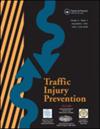Effect of data censoring on thoracic injury risk curves
IF 1.6
3区 工程技术
Q3 PUBLIC, ENVIRONMENTAL & OCCUPATIONAL HEALTH
引用次数: 0
Abstract
Objective
The first objective was to evaluate the effect of using less censored (i.e., exact and interval-censored) data on thoracic injury risk curves and the resulting injury probabilities. The second objective was to generate new injury risk curves to predict Abbreviated Injury Scale (AIS) 3+ rib fractures based on chest deflection.
Methods
Two data sets consisting of postmortem human surrogate (PMHS) tests with multipoint chest deflection measurements were compiled: A less censored data set consisting of exact and interval-censored data and a doubly censored data set consisting of left- and right-censored data. Chest deflection data from both data sets were processed in a consistent manner to calculate the maximum deflections at different locations across the chest. Survival analysis methods were used to generate nonparametric and parametric injury risk curves for serious skeletal injury. The total sample sizes and proportions of less censored data used to generate the risk curves were varied for each curve to evaluate the effects of sample size and less censored data on risk curve shape and predicted injury thresholds.
Results
Increasing the proportion of less censored data resulted in steeper injury risk curves and a higher predicted risk for a given amount of deflection. Differences in injury risk were more pronounced in the upper half of the injury risk curves. Introducing less censored data also produced narrower confidence intervals. At a total sample size of 79, increasing the percentage of less censored data from 0 to 30 had minimal effect on the shape of the risk curve.
Conclusions
Doubly censored chest deflection data have historically been used to generate thoracic injury risk curves for frontal motor vehicle crash events. This study found that incorporating less censored data into thoracic injury risk curves meaningfully affected the shape of the injury risk curves and their resulting injury risk predictions. All of the injury risk curves generated in the study predicted a lower threshold for serious rib fracture injury compared to previously developed injury risks curves that are currently in use in the field. Based on the results of this study, adding less censored data to injury risk curves should be strongly considered to improve thoracic injury risk curve prediction and confidence, especially for smaller sample sizes.
数据删减对胸廓损伤风险曲线的影响。
目标:第一个目标是评估使用较少删减(即精确删减和间隔删减)数据对胸部损伤风险曲线和由此产生的损伤概率的影响。第二个目标是生成新的伤害风险曲线,根据胸部偏转情况预测简易伤害量表(AIS)3+肋骨骨折:方法:编制了两套数据集,包括死后人体替代物(PMHS)测试和多点胸部偏转测量:一个由精确和间隔删失数据组成的较少删失数据集和一个由左删失和右删失数据组成的双重删失数据集。两组数据中的胸部偏转数据均以一致的方式进行处理,以计算胸部不同位置的最大偏转。采用生存分析方法生成非参数和参数骨骼严重损伤风险曲线。用于生成风险曲线的总样本量和较少删减数据的比例在每条曲线上都有所不同,以评估样本量和较少删减数据对风险曲线形状和预测伤害阈值的影响:增加较少删减数据的比例会导致伤害风险曲线更陡峭,在一定偏转量下的预测风险更高。在伤害风险曲线的上半部分,伤害风险的差异更为明显。引入较少删减的数据也会产生较窄的置信区间。在总样本量为 79 的情况下,将较少删减数据的百分比从 0 增加到 30,对风险曲线形状的影响微乎其微:双删减胸部变形数据历来用于生成正面机动车碰撞事件的胸部损伤风险曲线。这项研究发现,在胸部伤害风险曲线中加入较少删减的数据会对伤害风险曲线的形状和由此产生的伤害风险预测产生有意义的影响。与之前开发的、目前在现场使用的伤害风险曲线相比,本研究中生成的所有伤害风险曲线预测的严重肋骨骨折伤害阈值都较低。根据本研究的结果,应大力考虑在损伤风险曲线中添加删减较少的数据,以改善胸廓损伤风险曲线的预测和可信度,尤其是在样本量较小的情况下。
本文章由计算机程序翻译,如有差异,请以英文原文为准。
求助全文
约1分钟内获得全文
求助全文
来源期刊

Traffic Injury Prevention
PUBLIC, ENVIRONMENTAL & OCCUPATIONAL HEALTH-
CiteScore
3.60
自引率
10.00%
发文量
137
审稿时长
3 months
期刊介绍:
The purpose of Traffic Injury Prevention is to bridge the disciplines of medicine, engineering, public health and traffic safety in order to foster the science of traffic injury prevention. The archival journal focuses on research, interventions and evaluations within the areas of traffic safety, crash causation, injury prevention and treatment.
General topics within the journal''s scope are driver behavior, road infrastructure, emerging crash avoidance technologies, crash and injury epidemiology, alcohol and drugs, impact injury biomechanics, vehicle crashworthiness, occupant restraints, pedestrian safety, evaluation of interventions, economic consequences and emergency and clinical care with specific application to traffic injury prevention. The journal includes full length papers, review articles, case studies, brief technical notes and commentaries.
 求助内容:
求助内容: 应助结果提醒方式:
应助结果提醒方式:


